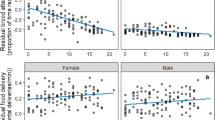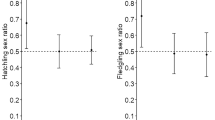Abstract
Labor division in parental care and reduction of inter-sex competition by division of the foraging niche have been suggested as part of the evolutionary basis for reversed sexual size dimorphism in boobies (Sulidae). To test the potential viability of both hypotheses for the maintenance of dimorphism, we studied parental care and foraging behavior of the Blue-footed Booby (Sula nebouxii) in two colonies in the Gulf of California, Mexico. Proportion of time spent at the nest, feeding frequency, and time devoted to nest defense were used as indicators of parental care. Foraging ecology was evaluated through the number and duration of foraging trips, proportion of time dedicated to flight and to active feeding, rate and depth of diving, and diet. We found some inter-sex differences in foraging only under high demand conditions, such as food shortage or large broods. Inconsistent inter-sex differences seem to be part of a strategy to maximize chick rearing under a variable environmental regime.


Similar content being viewed by others
References
Álvarez-Borrego S (2002) Physical Oceanography. In: Case T, Cody ML, Ezcurra E (eds) A New Island biogeography of the Sea of Cortés. Oxford University Press, New York, pp 41–59
Anderson DJ, Ricklefs RE (1992) Brood size and food provisioning in masked and Blue-footed Boobies (Sula spp). Ecology 73:1363–1374
Andersson M, Norberg RA (1981) Evolution of reversed sexual size dimorphism and role partitioning among predatory birds, with a size scaling of flight performance. Biol J Linn Soc 15:105–130
Awkerman JA, Hobson K, Anderson DJ (2007) Isotopic (δ 15 N and δ 13C) evidence for intersexual foraging differences and temporal variation in habitat use in waved albatrosses. Can J Zool 85:273–279
Barrett RT, Furness RW (1990) The prey and diving depths of seabirds on Hornøy, North Norway after a decrease in the Barents Sea Capelin stocks. Ornis Scand 21:179–186
Boag PT, Grant PR (1981) Intense natural selection in a population of Darwin′s finches (Geospizinae) in the Galápagos. Science 214:82–85
Burger AE, Wilson RP (1988) Capillary-tube depth gauges for diving animals: an assessment of their accuracy and applicability. J Field Ornithol 59:345–354
Fairbairn J, Shine R (1993) Patterns of sexual size dimorphism in seabirds of the southern hemisphere. Oikos 68:139–145
Gilardi JD (1992) Sex-specific foraging distributions Brown Boobies in the Eastern Tropical Pacific. Colonial Waterbirds 15:148–151
González-Bernal MA, Mellink E, Fong-Mendoza JR (2002) Nesting birds of Farallón de San Ignacio, Sinaloa, México. Western Birds 33:254–257
González-Solís J, Croxall JP, Wood AG (2000) Sexual dimorphism and sexual segregation in foraging strategies of northern giant petrels, Macronectes halli, during incubation. Oikos 90:390–398
Guerra M, Drummond H (1995) Reversed sexual size dimorphism and parental care: minimal division of labour in the blue-footed booby. Behaviour 132:479–496
Hendrick AV, Temeles JE (1989) The evolution of sexual dimorphism in animals: hypotheses and tests. Trends Ecol Evol 4:136–138
Ishikawa K, Watanuki Y (2002) Sex and individual differences in foraging behavior of Japanese cormorants in years of different prey availability. J Ethol 20:49–54
Korpimäki E (1986) Reversed size dimorphism in birds of prey, especially in Tengmalm's owl Aegolius funereus: a test of the starvation hypothesis. Ornis Scandinavica 17:326–332
Lewis S, Sherratt TN, Hammer KC, Wanless S (2001) Evidence of intra-specific competition for food in a pelagic seabird. Nature 412:816–819
Lewis S, Benvenuti S, Dall’Antonia L, Griffiths R, Money L, Sherratt TN, Wanless S, Hamer KC (2002) Sex-specific foraging behaviour in a monomorphic seabird. Proc R Soc Lond B 269:1687–1693
Lewis S, Schreiber EA, Daunt F, Schenk GA, Orr K, Adams A, Wanless S, Hamer KC (2005) Sex-specific foraging behaviour in tropical boobies: does size matter? Ibis 147:408–414
Litzow MA, Piatt JF (2003) Variance in prey abundance influences time budgets of breeding seabirds: evidence from pigeon guillemots Cepphus columba. J Avian Biol 34:54–64
Lormee H, Barbraud C, Chastel O (2005) Reversed sexual size dimorphism and parental care in the red-footed booby Sula sula. Ibis 147:307–315
Montevecchi WA (1993) Birds as indicators of change in marine prey stocks. In: Furness RW, Greenwood JDD (eds) Birds as monitors of environmental change. Chapman and Hall, London, pp 217–266
Nelson JB (1978) The Sulidae: gannets and boobies. Oxford University Press, London
Phillips RA, Silk JRD, Phalan B, Catry P, Croxall JP (2004) Seasonal sexual segregation in two Thalassarche albatross species: competitive exclusion, reproductive role specialization or foraging niche divergence? Proc R Soc Lond B 271:1283–1291
Price T (1987) Diet variation in a population of Darwin’s finches. Ecology 68:1015–1028
Serrano-Meneses MA, Székely T (2006) Sexual size dimorphism in seabirds: sexual selection, fecundity selection and differential niche-utilisation. Oikos 113:385–394
Snyder NFR, Wiley JW (1976) Sexual dimorphism in hawks and owls of North America. Ornithol Monogr 20:1–96
Tershy BR, Croll DA (2000) Parental investment, adult sex ratios, and sexual selection in a socially monogamous seabird. Behav Ecol Sociobiol 48:52–60
Velando A, Alonso-Alvarez C (2003) Differential body condition regulation by males and females in response to experimental manipulations of brood size and parental effort in the blue-footed booby. J Anim Ecol 72:846–856
Weimerskirch H, Le Corre M, Ropert-Coudert Y, Kato A, Marsac F (2006) Sex-specific foraging behaviour in a seabird with reversed sexual dimorphism: the Red-footed Booby. Oecologia 146:681–691
Zar JH (1996) Biostatistical analysis. Prentice Hall, USA
Zavalaga CB, Benvenuti S, Dall′Antonia L, Emslie SD (2007) Diving behavior of blue-footed boobies Sula nebouxii in northern Peru in relation to sex, body size and prey type. Mar Ecol-Prog Ser 336:291–303
Zavalaga CB, Benvenuti S, Dall’Antonia L, Emslie SD (2008) Foraging areas of breeding blue-footed boobies Sula nebouxii in northern Peru, as determined by direction recorders. J Avian Biol 39:405–412
Acknowledgments
Betty Ann Schreiber kindly provided the data loggers. CONACYT (SEP-2004-C01-45995) and CICESE funded our field work. CONACYT also supported J.A.C.-G. through a scholarship. Aaron Aguilar, Marco A. Gonzalez-Bernal and his family provided logistic support. Aaron Aguilar, Miguel Prado, Erik A. Peñaloza and Fabiola Cárdenas assisted during field work. Jill Awkerman,Guillermo Fernández and Will Stein provided editorial advice. We are grateful to all of them. Fieldwork carried out for this study complied with applicable Mexican laws (permits SGPA/DGVS/00610, SGPA/DGVS/08203, and SGPA/DGVS/08089/06 to E. Mellink).
Author information
Authors and Affiliations
Corresponding author
Additional information
Communicated by P. H. Becker.
Rights and permissions
About this article
Cite this article
Castillo-Guerrero, J.A., Mellink, E. Occasional inter-sex differences in diet and foraging behavior of the Blue-footed Booby: maximizing chick rearing in a variable environment?. J Ornithol 152, 269–277 (2011). https://doi.org/10.1007/s10336-010-0575-z
Received:
Revised:
Accepted:
Published:
Issue Date:
DOI: https://doi.org/10.1007/s10336-010-0575-z




